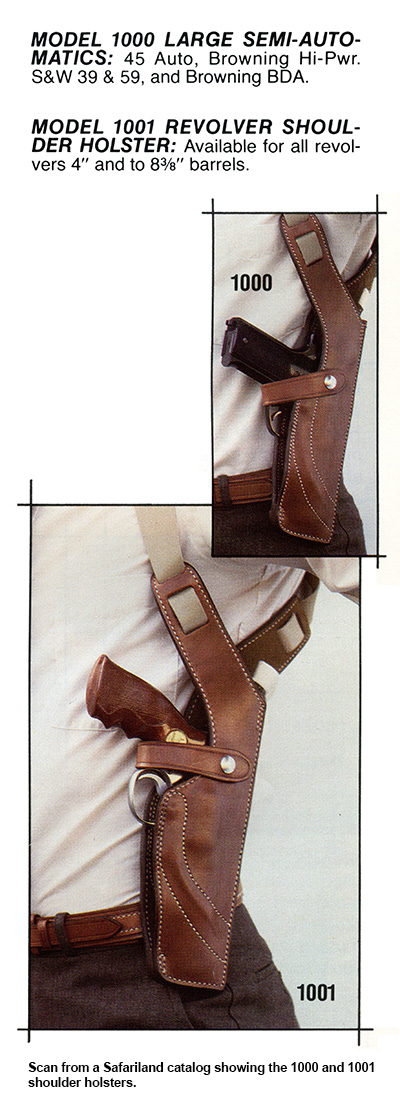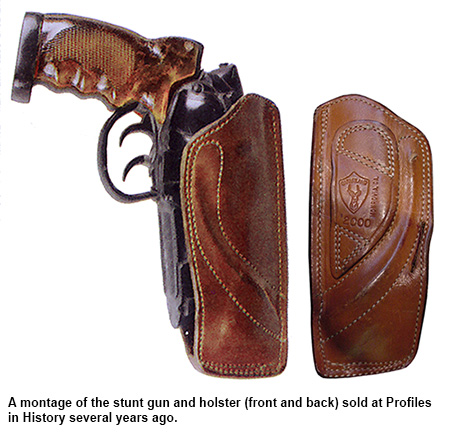Creating the Deckard Holster
by Phil Steinschneider
Introduction
In the late 1990s, once the original firearms employed to build the Blade Runner Deckard blaster had been identified, the natural follow-up was to move on to the holster. In the course of speaking with Art Shippee (the unofficial property master on the film) in the early conversations about the blaster, he had indicated that a brass blank of the gun had been produced that the production had sent to Safariland so holsters could be made. Contacting Safariland directly in the early 2000s proved to be a dead end, however, as no one at the company seemed to have any information, or the wherewithal to dig it up, on the work done for the Blade Runner production.
 For the longest time, this researcher followed all kinds of different leads, purchasing countless examples and browsing through dozens of holster catalogues issued by numerous manufacturers. At one point, Bianchi was believed to be the maker, which led to the purchase and review of numerous vintage catalogs. It was only by accident, while monitoring Safariland holster auctions on ebay, that this researcher stumbled on an interesting sale for an unusual holster, known as the Model 1000. It was made by Safariland for a relatively short time in the first part of the 1980s. This information was subsequently shared with Craig Kovach, who was able to find the rare copy of a catalog showing the various models of this holster made at the time by Safariland.
For the longest time, this researcher followed all kinds of different leads, purchasing countless examples and browsing through dozens of holster catalogues issued by numerous manufacturers. At one point, Bianchi was believed to be the maker, which led to the purchase and review of numerous vintage catalogs. It was only by accident, while monitoring Safariland holster auctions on ebay, that this researcher stumbled on an interesting sale for an unusual holster, known as the Model 1000. It was made by Safariland for a relatively short time in the first part of the 1980s. This information was subsequently shared with Craig Kovach, who was able to find the rare copy of a catalog showing the various models of this holster made at the time by Safariland.
Furthermore, in order to verify that this was indeed the correct candidate, several Model 1000 holsters, and the very similar Model 1001, were purchased over time and analyzed for their suitability for use as the Rick Deckard hip holster. As time progressed, it became clear that the Model 1000 was close, but not quite right.
Based on repeated analysis of the versions produced during that period, it was soon obvious that the Deckard holster was custom-modified from an off-the-shelf Safariland Model 1001. Most likely, it was the variation created for the Smith & Wesson 5" revolver that was chosen and then adapted. Since the hip holsters made by Safariland during the period did not quite match either, it appears that a shoulder holster was altered by trimming its "ears" and repurposing it as a belt-mounted variation. Why Safariland chose a modified shoulder holster over an existing hip version is unknown, but there must have been practical considerations that made this the most convenient choice.
 Additionally, a few years after identifying the Safariland Model 1001 as the base holster for the Deckard unit, Blade Runner expert and uberfan Gary Willoughby was able to view and photograph an original Deckard holster presented for sale at a Profiles in History auction in Los Angles, California. This particular copy was mated to a stunt blaster that was subsequently sold to Microsoft cofounder Paul Allen and is now on display at the Sci-Fi museum in Seattle, Washington. Thanks to these images, the fact that a Safariland holster had been used was confirmed, as the custom belt loop on the back of the prop not only had the famous Safariland antelope stamp on it, but a unique model number of '2000' as well. Since the prop was made in 1981 and the value does not match any known Safariland product models of the day, the number was quite likely chosen in homage to the film. Although the numeral representing the year during which Blade Runner takes place (2019) would certainly have been cooler, the earlier year-like number is just as fascinating and compelling.
Additionally, a few years after identifying the Safariland Model 1001 as the base holster for the Deckard unit, Blade Runner expert and uberfan Gary Willoughby was able to view and photograph an original Deckard holster presented for sale at a Profiles in History auction in Los Angles, California. This particular copy was mated to a stunt blaster that was subsequently sold to Microsoft cofounder Paul Allen and is now on display at the Sci-Fi museum in Seattle, Washington. Thanks to these images, the fact that a Safariland holster had been used was confirmed, as the custom belt loop on the back of the prop not only had the famous Safariland antelope stamp on it, but a unique model number of '2000' as well. Since the prop was made in 1981 and the value does not match any known Safariland product models of the day, the number was quite likely chosen in homage to the film. Although the numeral representing the year during which Blade Runner takes place (2019) would certainly have been cooler, the earlier year-like number is just as fascinating and compelling.
 Also, it was later observed that Captain Bryant wore a shoulder holster of some kind on screen. The visible straps looked eerily similar to those of the 1000 series Safariland holsters. When this prop also eventually surfaced in the collector's market, the fact that it was an unaltered Safariland 1001 shoulder holster helped further confirm that the Deckard holster was certainly descended from the standard 1001 model designed for the Smith & Wesson 5" revolver.
Also, it was later observed that Captain Bryant wore a shoulder holster of some kind on screen. The visible straps looked eerily similar to those of the 1000 series Safariland holsters. When this prop also eventually surfaced in the collector's market, the fact that it was an unaltered Safariland 1001 shoulder holster helped further confirm that the Deckard holster was certainly descended from the standard 1001 model designed for the Smith & Wesson 5" revolver.
In conclusion, the search for the correct Rick Deckard Blade Runner blaster holster was an endeavor fraught with false leads that seemed to go on interminably with long odds of ever being resolved. The effort nonetheless proved to be just as rewarding as the one expended on the sidearm. In fact, it was even harder and more complicated to identify this particular prop than the blaster, as the Safariland Model 1000 and Model 1001 shoulder holsters were produced for only one or two years, and so few appear to have been manufactured.